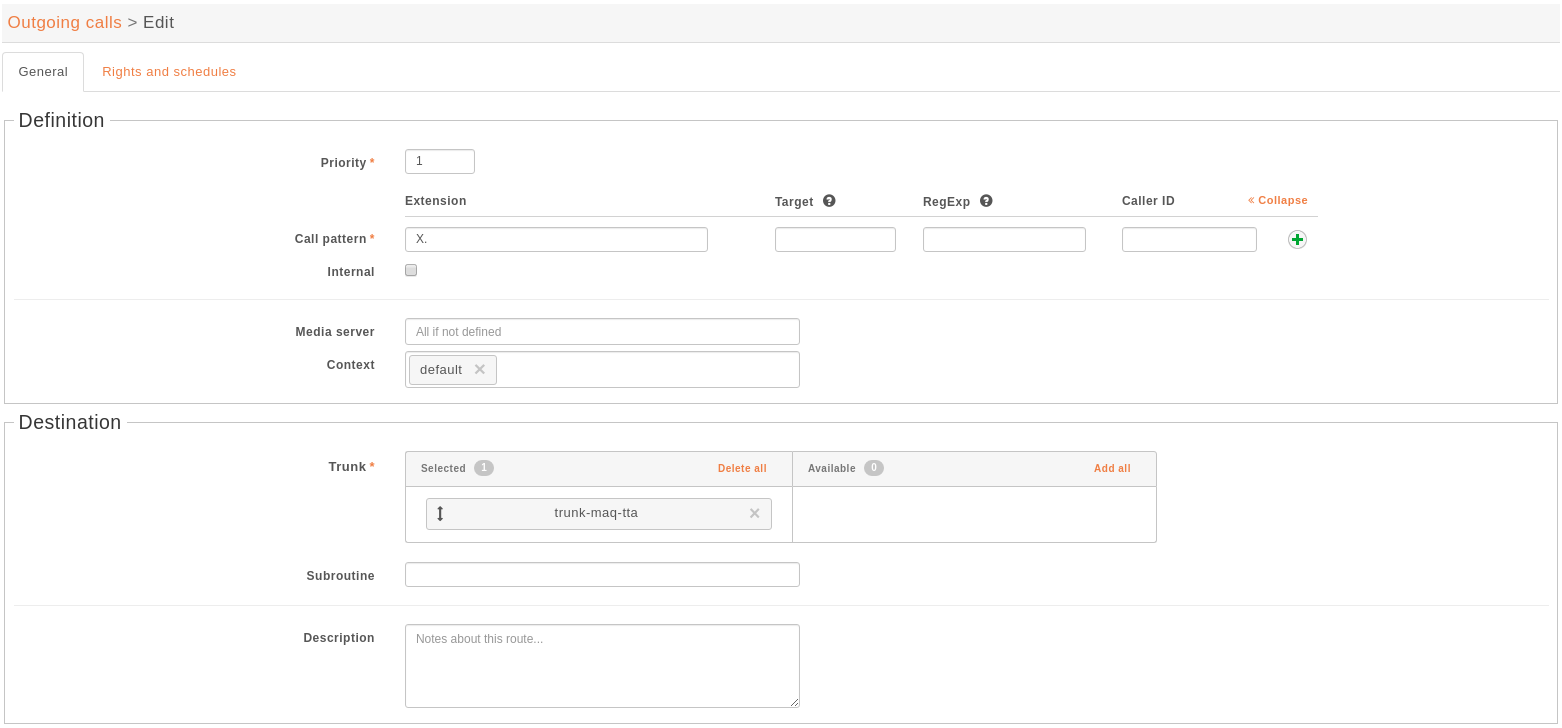Outgoing Calls
You can configure outgoing calls settings in .
An outgoing call is composed with a definition of a outgoing route (the extension patterns that should match) and a destination (a trunk owned by a media server).

Definition
A route can define
Priority: A number that will prioritize a route compare to another one, if both routes are available for a same matching extension.
Call Pattern:
Extension: The pattern that will match an extension. More details on the Asterisk wiki.
(advanced) RegExp: A pattern that will match the dialed number - see Dialed Number Transformation below.
(advanced) Target: The transformation to apply to the dialed number - see Dialed Number Transformation below.
(advanced) Caller ID: Override the presented number once call is performed.
Internal: set the route to forward the internal caller’s caller ID to the trunk. This option is useful when the other side of the trunk can reach the user with it’s caller ID number.
Media server: define the route only for specific media server.
Context: define the route only for specific context.
Dialed Number Transformation
The fields RegExp and Target can be used to change the dialed number before it is sent via the trunk defined in the Route.
Basically one uses:
the RegExp field to define a pattern that will match the dialed number
and the Target field to define how to transform the dialed number
Below are some examples of how you can take advantage of RegExp and Target:
Add or Remove Prefix
Regexp |
Target |
Result |
|---|---|---|
0(.*) |
\1 |
Delete prefix 0 from dialed number and keep the rest (e.g. 00123456789 → 0123456789) |
14(.*).. |
\1 |
Delete prefix 14 and last two digits from dialed number and keep the rest (e.g. 1455660 → 556) |
.{1}(.*) |
\1 |
Delete leading digit from dialed number and keep the rest (e.g. 03601 → 3601) |
+33(.*) |
0\1 |
Replcae leading +33 with 0 from dialed number and keep the rest (e.g. +33123456789 → 0123456789) |
0(.*) |
+33\1 |
Replace leading 0 with +33 from dialed number with 33 (e.g. 0123456789 → +33123456789) |
14(.*).. |
33\18 |
Delete prefix 14 and last two digits, and then prefix the dialed number with 33 and suffix it with 8 (1455660 → 335568) |
Change the Number
Regexp |
Target |
Result |
|---|---|---|
(.*) |
\1 |
Get whole called number (e.g. 0123456789 → 0123456789) |
(.*) |
445 |
Replace called number with 445 number (e.g. 0123456789 → 445) |
Destination
Once route is defined and therefore can be selected if an extension match the route, you need to set the wanted destination. A route destination is materialized by:
Trunk: SIP or Custom trunk that will be used to reach desired network.
Subroutine: Subroutine to apply once route has been selected.
Rights and schedules
A route can define rights aka call permissions, it means that a call can be discarded if missing the right to use this route. The same applies for schedules where you can define time slots of availability of the route.